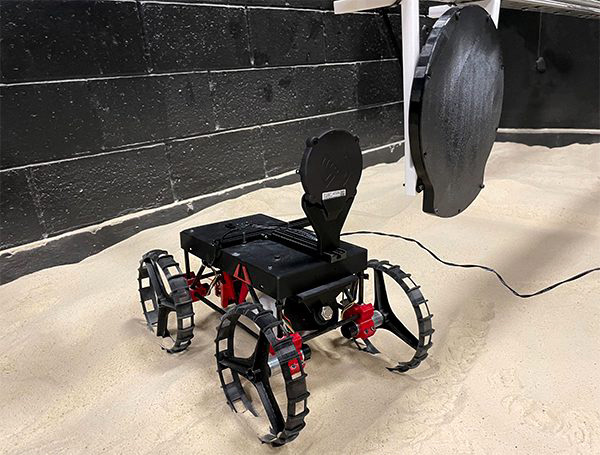
Astrobotic
Astrobotic’s Wireless Charging System for the Moon Can Survive Lunar Night (News Release - June 16)
Astrobotic’s wireless charging system can successfully power a CubeRover in lunar night conditions
Pittsburgh, PA - A wireless charging system developed by Astrobotic and WiBotic, with assistance from Bosch, the University of Washington (UW), and the NASA Glenn Research Center (GRC), successfully passed testing to prove that it can function and provide enough power for technologies to survive the 14-Earth-day lunar night.
During testing, the lightweight, ultra-fast wireless charging system proved it can transmit power in extreme hot and cold lunar temperatures simulated at Astrobotic’s headquarters in Pittsburgh, Pennsylvania. The analysis and final report, co-authored by NASA Glenn Research Center, maintains the wireless system out-performed its target requirements.
When on the lunar surface, the wireless system would deliver power from an Astrobotic lunar lander or Vertical Solar Array Technology (VSAT) to power rovers, habitats, in-situ resource utilization plants, and other large surface infrastructure to survive the lunar night. Power from the source is converted to wireless power by a WiBotic transmitter circuit and is sent to the device by a transmitter antenna coil. The transmitter coil, however, must be located outside the lander to be available to a wide range of battery-powered devices. As a result, the coil will be exposed to lunar temperatures ranging from -180°F to 220°F. To test its ability to withstand these extremes, the coil was rapidly moved from a heated space into a liquid nitrogen chamber at Astrobotic while power transfer continued.
This successful test follows prior successful tests of exposing the wireless charging system to several different regolith simulants at the NASA Kennedy Space Center, where the system was covered in 4 cm of regolith and experienced no performance degradation to power transfer.
“These tests demonstrate that Astrobotic’s wireless chargers are ready to distribute power for customers on the Moon. Our chargers are now proven to transmit in extreme temperatures, harsh dust environments, and on uneven terrain - all at an 80-85% total system efficiency. This is a huge leap from lunar power systems that in the past relied on complex, heavy, and power-hungry methods. These new, vital systems can enable Artemis Program operations and commercial lunar activities,” says Jay Eckard, Senior Project Manager for Lunar Surface Systems at Astrobotic.
“Even in the worst-case scenario with a fully-exposed radiator panel, our wireless charging system was equipped to provide heater power for CubeRover to survive the lunar night. And CubeRover is just the start. By enabling night survival, we’re opening the Moon to more science activity, for much longer than ever before,” added Eckard.
The wireless charging system is slated to undergo a Preliminary Design Review in early July, with a space-rated engineering model being manufactured in tandem. In the coming months the system will be subjected to a full space qualification test campaign, where it will be exposed to the launch loads of a rocket, among other challenging tests. Astrobotic is already offering the system for commercial purchase in 125w and 400w configurations.
Source: Astrobotic
****

Astrobotic

No comments:
Post a Comment